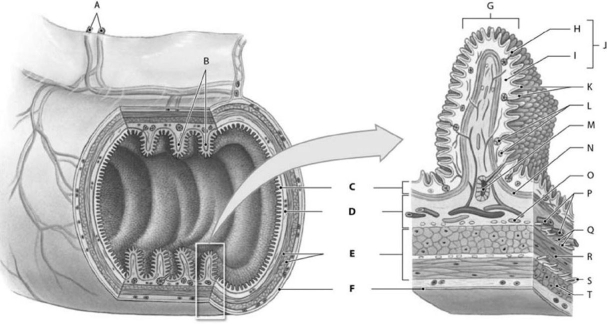A) myenteric plexus
B) artery and vein
C) lymphatic vessel
D) submucosal plexus
E) mucosal glands
Correct Answer

verified
Correct Answer
verified
Multiple Choice
Which of the following produces secretions with mostly buffers and mucus, but few enzymes?
A) parotid and submandibular salivary glands
B) parotid salivary glands only
C) sublingual and parotid salivary glands
D) submandibular and sublingual salivary glands
E) pancreas and parotid salivary glands
Correct Answer

verified
Correct Answer
verified
Multiple Choice
The layer of the digestive tract that underlies the mucosal epithelium and consists of areolar connective tissue is the
A) lamina propria.
B) submucosa.
C) muscularis.
D) serosa.
E) adventitia.
Correct Answer

verified
Correct Answer
verified
Multiple Choice
The pancreatic duct penetrates the duodenal wall with the
A) cystic duct.
B) hepatic portal vein.
C) common hepatic duct.
D) common hepatic artery.
E) common bile duct.
Correct Answer

verified
Correct Answer
verified
Multiple Choice
The region of the stomach superior to the cardia is the
A) rugae.
B) pylorus.
C) fundus.
D) antrum.
E) body.
Correct Answer

verified
Correct Answer
verified
Multiple Choice
Cholecystokinin from the intestinal wall is stimulated by the presence of
A) lipids and partially digested proteins in the duodenum.
B) proteins and partially digested lipids in the duodenum.
C) lipids and partially digested carbohydrates in the duodenum.
D) proteins and partially digested carbohydrates in the duodenum.
E) carbohydrates and partially digested lipids in the duodenum.
Correct Answer

verified
Correct Answer
verified
Multiple Choice
Maltase, sucrase, and lactase are carbohydrases produced by the
A) small intestine.
B) liver.
C) parotid salivary gland.
D) pancreas.
E) stomach.
Correct Answer

verified
Correct Answer
verified
Multiple Choice
The human liver is typically composed of ________ lobe(s) .
A) one
B) two
C) three
D) four
E) five
Correct Answer

verified
Correct Answer
verified
Multiple Choice
The pH of saliva is
A) highly basic.
B) slightly basic.
C) neutral.
D) slightly acidic.
E) very acidic.
Correct Answer

verified
Correct Answer
verified
Multiple Choice
 Figure 16-1 Structural Components of the Digestive Tract
Use Figure 16-1 to identify the labeled part.
-Label L represents which structure(s) ?
Figure 16-1 Structural Components of the Digestive Tract
Use Figure 16-1 to identify the labeled part.
-Label L represents which structure(s) ?
A) mucosal glands
B) mucosa
C) villi
D) mucous epithelium
E) lamina propria
Correct Answer

verified
Correct Answer
verified
Multiple Choice
 Figure 16-1 Structural Components of the Digestive Tract
Use Figure 16-1 to identify the labeled part.
-Label A represents which structure(s) ?
Figure 16-1 Structural Components of the Digestive Tract
Use Figure 16-1 to identify the labeled part.
-Label A represents which structure(s) ?
A) myenteric plexus
B) mesenteric artery and vein
C) lymphatic vessel
D) submucosal plexus
E) mucosal gland
Correct Answer

verified
Correct Answer
verified
Multiple Choice
The lesser omentum is
A) a major portion of the stomach.
B) attached to the stomach at the greater curvature.
C) important in the digestion of fats.
D) a fatty sheet that hangs like an apron over the abdominal viscera.
E) a mesentery that extends from the stomach to the liver.
Correct Answer

verified
Correct Answer
verified
Multiple Choice
The space between the cheeks or lips and the teeth is called the
A) pharynx.
B) larynx.
C) epiglottis.
D) vestibule.
E) cheek.
Correct Answer

verified
Correct Answer
verified
Multiple Choice
The oral cavity, pharynx, esophagus, and rectum have an adventitia in place of the
A) mucosa.
B) lamina propria.
C) serosa.
D) muscularis externa.
E) submucosa.
Correct Answer

verified
Correct Answer
verified
Multiple Choice
Which phase of swallowing begins with compression of the bolus against the hard palate?
A) esophageal
B) gastric
C) buccal
D) pharyngeal
E) duodenal
Correct Answer

verified
Correct Answer
verified
Multiple Choice
Rugae are
A) mucosal ridges in the stomach.
B) involved in absorption of liquids from the stomach.
C) pockets in the lining of the stomach that contain secretory cells.
D) located in the esophagus.
E) present when the stomach is at maximum distention.
Correct Answer

verified
Correct Answer
verified
Multiple Choice
The oral cavity, pharynx, esophagus, and anus are lined by
A) pseudostratified ciliated columnar epithelium.
B) cuboidal epithelium.
C) stratified squamous epithelium.
D) simple epithelium.
E) simple columnar epithelium.
Correct Answer

verified
Correct Answer
verified
Multiple Choice
Functions of the large intestine include
A) chemical digestion of chyme.
B) temporary food storage.
C) reabsorption of water and compaction of feces.
D) absorption of the products of digestion.
E) production of digestive enzymes.
Correct Answer

verified
Correct Answer
verified
Multiple Choice
The esophagus passes through a hole in the diaphragm called the
A) esophageal hiatus.
B) cardia.
C) pylorus.
D) upper esophageal sphincter.
E) lower esophageal sphincter.
Correct Answer

verified
Correct Answer
verified
Multiple Choice
The basic functional units of the liver are the
A) hepatocytes.
B) liver cells.
C) lobules.
D) portal areas.
E) bile canaliculi.
Correct Answer

verified
Correct Answer
verified
Showing 81 - 100 of 129
Related Exams